Debra A. Barsotti
Research Journalist
Citizens United to Protect the Maurice River
and Its Tributaries, Inc.
The Maurice River Reaches Project
Spillway
Reach #1
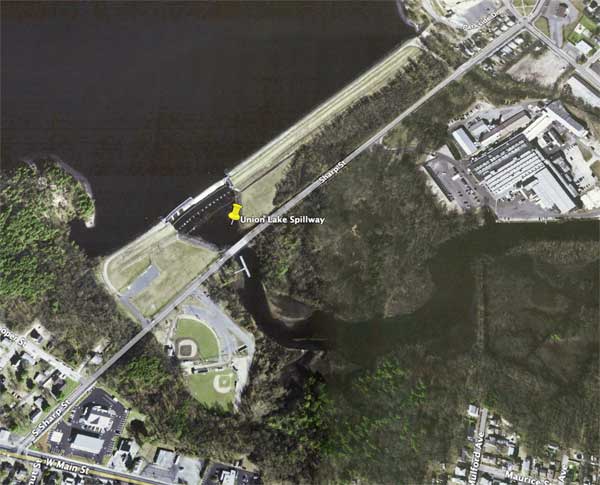 It was Labor Day, 1940. "The water came up 4 feet above normal. The lake spilled over into what is now Union Lake Park and into the third ward, across Sharp Street along Columbia Avenue," said Robert Francois as he related the story that his grandfather, Albert Beebe, often reconstructed for him.
It was Labor Day, 1940. "The water came up 4 feet above normal. The lake spilled over into what is now Union Lake Park and into the third ward, across Sharp Street along Columbia Avenue," said Robert Francois as he related the story that his grandfather, Albert Beebe, often reconstructed for him.
Francois said that that there were no floodgates on the canal at the time. Concerns grew as the water level rose. On that day in 1940, the entire town came out to help with a sandbagging operation that stretched from Union Lake and all the way across Broad Street, up to the Millville Manufacturing Company. The efforts were successful and the spillway held.
Click here for images of the 1940 flood.
Two centuries earlier, these concerns didn't exist. The development of Millville was precipitated in the late 1700's, when enterprising businessmen began to turn to the region's waterways as a source of energy and a means of transport for the abundant resources they were beginning to harvest.
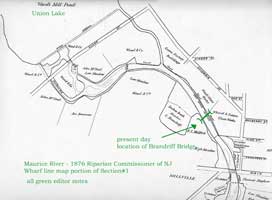 Before Millville was established, before Union Lake (or in its infancy, Union Pond) was created, this regional destination on the northern stretches of the Maurice River was known as Shingle Landing. To businessmen and travelers of the era, the primitive port and river crossing was a link to prosperity.
Before Millville was established, before Union Lake (or in its infancy, Union Pond) was created, this regional destination on the northern stretches of the Maurice River was known as Shingle Landing. To businessmen and travelers of the era, the primitive port and river crossing was a link to prosperity.
Two of the businessmen who saw the potential of the location in Cumberland County were Henry Drinker and Joseph Smith. Around 1790, they purchased parcels of land, including 19,000 acres belonging to the sons of William Penn. Drinker, Smith and a few others formed the Union Company, which took ownership of nearly 20,000 acres around, and including, the land that is now part of downtown Millville. The Union Company built a dam and created a network of mills that drew power from the harnessed waters of their Union Mill Dam.
They installed large floating gates to 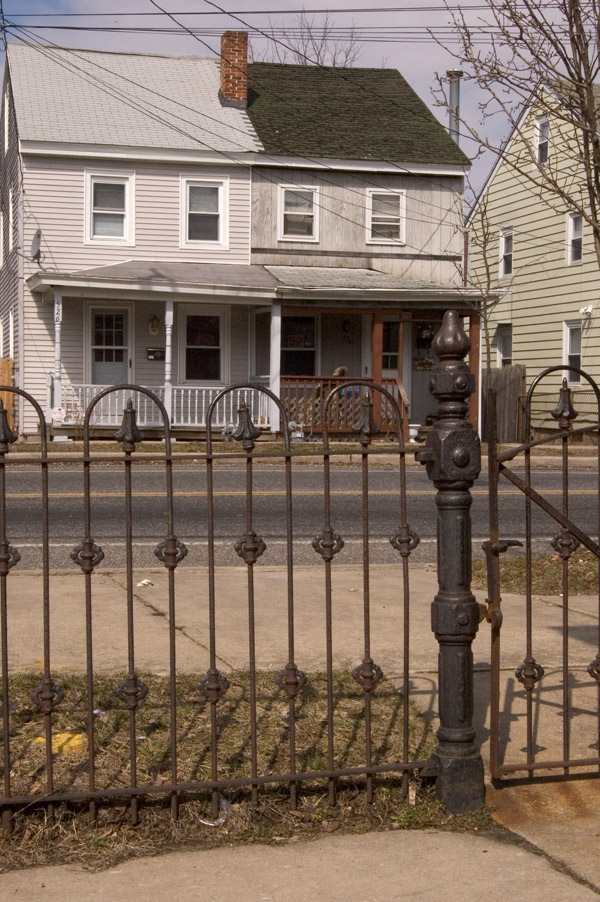 allow logs to pass through the dam and down river to be loaded and shipped to market.
allow logs to pass through the dam and down river to be loaded and shipped to market.
During the subsequent decades, the Union Company's holdings passed through several different owners. Slow and steady development was accelerated when the Union Company was purchased by David Wood and Edward Smith. In 1814, they established the R. D. Wood and Company, a blast iron foundry on Columbia Avenue, which dealt with iron castings for stove plates and similar products. Richard D. Wood purchased the company in 1840 and built two larger foundries to cast gas and water pipes.
In 1854, Richard Wood established a cotton mill next to the foundries, and then added a bleachery and dye house in 1860. The industrial complex was united under the name of Millville Manufacturing Company, and grew to be one of the region's most extensive manufacturing facilities. The need for increased power was remedied in 1869 when Wood built a new dam over the mill's pond. His project created the 890-acre Union Lake, one of the largest manmade lakes in New Jersey (see account attributable to Sam Souder).
An article from the Bridgeton Evening News (July 17, 1933) included a written account of Millville resident Hugh Smith, who recounted his boyhood memory of the events surrounding the creation of the new dam.
Smith recalled that he was on his way to school when he discovered a break in the canal bank leading to Union Lake. The waters flooded a warehouse filled with bales of cotton. Smith recalled that hundreds of the cotton bales washed out with the flood waters and floated down the Maurice River. A few years later, when he was 12, and already working a 12-hour shift at the Millville Manufacturing Company, there was another break in the canal. Smith reminisced about the townspeople who gathered to make the repairs, and how they were fed by with a supply of sandwiches and coffee made by the women of the town.
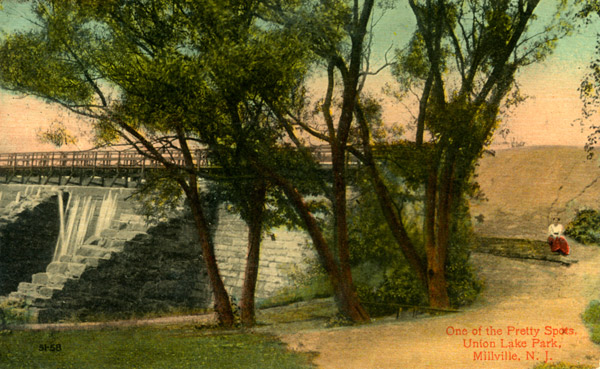 Smith wrote that after those breaches, a decision was made to construct a large dam with floodgates. According to Smith, the stone for the new dam was quarried from White Marsh Swamp, just a mile from the lake. In his account, he gave details of how the hand-shaped stones were transported, one by one, in a special cart with "wheels seven feet high." Smith recalled the anxiety of residents as a bulge appeared in the middle of the dam wall when the water flow was first restored. Richard Wood returned from a trip to Philadelphia to supervise the fortification of the wall. With the efforts of the townspeople, stone buttresses shored-up the wall, averting a major flood. Smith also recalled that Richard Smith met his demise soon after this event, succumbing to pneumonia contracted after the long anxious hours.
Smith wrote that after those breaches, a decision was made to construct a large dam with floodgates. According to Smith, the stone for the new dam was quarried from White Marsh Swamp, just a mile from the lake. In his account, he gave details of how the hand-shaped stones were transported, one by one, in a special cart with "wheels seven feet high." Smith recalled the anxiety of residents as a bulge appeared in the middle of the dam wall when the water flow was first restored. Richard Wood returned from a trip to Philadelphia to supervise the fortification of the wall. With the efforts of the townspeople, stone buttresses shored-up the wall, averting a major flood. Smith also recalled that Richard Smith met his demise soon after this event, succumbing to pneumonia contracted after the long anxious hours.
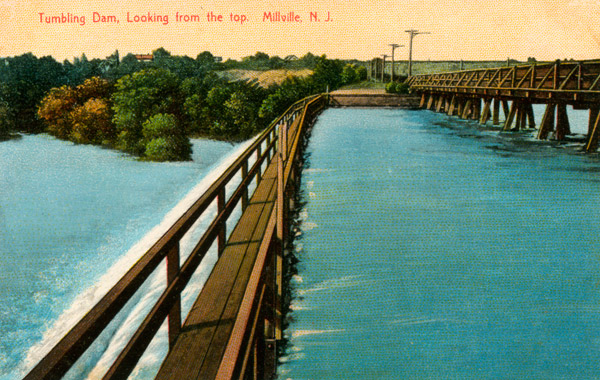
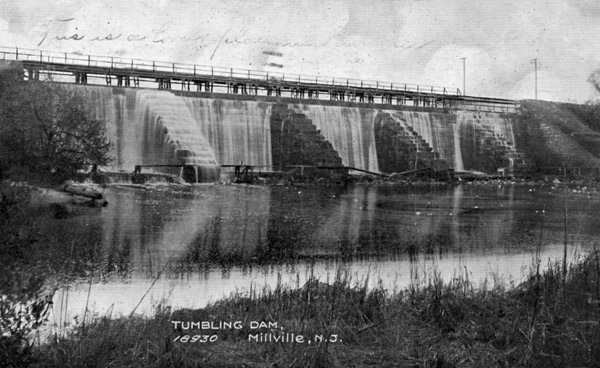
Life and development continued in the community. By the early 1900's, a wooden catwalk was constructed over the dam. Vintage photos captured a lively scene on Millville's "Tumbling Dam." Photos of a trolley (circa 1900), built by the South Jersey Traction Company to connect Millville to Bridgeton, illustrate the prominence of the manufacturing town that was coaxed from the banks of the Maurice River at the unimposing waterfront of Shingle Landing.

The Maurice River Company, one of the Wood family's divisions, maintained control of Union Lake and the dam until they sold it to the State of New Jersey in 1981. Robert Francois worked for the company, first as a caretaker of the lake, then as overseer of the dam. Francois said that because the dam was old, the old stone wall needed repointing every ten years or so. That had to be completed during a dry season, usually in the fall. The lake waters would be diverted down the canal and through the raceway to the old plant. Once the wall dried, it was repointed. The Maurice River Company brought in an engineer when the problems appeared to be more serious.
Francois became familiar with the workings of the dam. He explained that the gate of the old dam was manually opened and closed. When the waters on the lake rose, 8-foot lengths of plank (2x6) were pulled up to release the waters behind the gate. In the middle section was a "Fabri Dam". This device, made by Firestone, could be inflated or deflated, much like a giant balloon. Depending on the air temperature, water or air was used to inflate the Fabri Dam, adjusted based on the level of water coming into the lake. This was on top of the stone spillway. The spillway was then, and is now, 200 feet long. Planks from the 1800's were used for the wooden gates that protected the 50-foot spans on either side of the river. The Fabri Dam was centered over the remaining 100 feet.
Francois discussed the system he devised so that water could be used in the Fabri dam year-round. The use of a circulation pump kept the water in the inflatable sack from freezing during the winter. That made it easier to regulate the height of this part of the dam, allowing the lake water to flow evenly instead of allowing pressure to build up along the center-most section of the dam.
In June of 1987, NJ Governor Tomas Kean approved a $15 million appropriation to replace the spillway and earthen dam. In 1989, the Conti Corporation completed constructed on Union Lake's concrete gravity dam. This modern dam has sluice gates to control water levels in the lake, a spillway and an emergency spillway and an aluminum fish ladder.
Jane Galetto shed some light on the addition of the fish ladder. "For nearly 120 years spawning anadromous fish (i.e. Alewife, or the blue back herring) were not able to make their migrations to the headwaters of the Maurice River," Galetto said. "With the new structure these historic migrations have resumed. Today, during the springtime herring run, we can witness fisherman on the bridges of downtown Millville catching these prized fish.".
 click to navigate the map "up".
click to navigate the map "up". click to navigate the map "down".
click to navigate the map "down". click to navigate the map "left".
click to navigate the map "left". click to navigate the map "right".
click to navigate the map "right". click to "zoom in" for a closer look.
click to "zoom in" for a closer look. click to "zoom out" to back away from the map.
click to "zoom out" to back away from the map. click to get back to the "default" map setting.
click to get back to the "default" map setting. click to learn more about that reach.
click to learn more about that reach.





